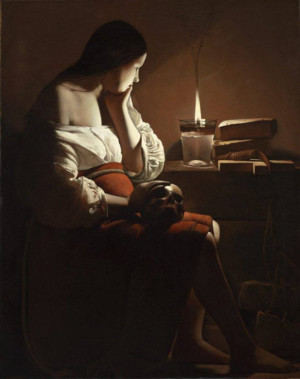 Reviewed by Ewart Shaw, Saturday 9th June 2018.
Reviewed by Ewart Shaw, Saturday 9th June 2018.
Rather like the song,
Smoke Gets in Your Eyes, the title of this Ensemble Galante concert,
The Smoking Flame, hints at the tears of love you experience when you are drawn to its flame.
While this intimate musical event took place a month ago, and the Cabaret Festival and Fringe have intervened, along with many other musical and theatrical events, I can't get it out of my head and hope that it marks a revival of interest in a significant part of western music.
While Rameau and Lully are the best-known composers of the era, this concert by Ensemble Galante and two visiting artists featured works by composers almost unknown, Clerambault being, perhaps, the only one with any profile.
Back in the 1970s, there was a flourish of interest in French Baroque music, with the establishment of the Armidian players, and the presentation during the1972 Festival of Arts of Pygmalion by Rameau. It was on a double bill with the cantata The Forges of Lemnos by Bernier, which underwent a slight change of focus due to a typographical error.
I was in the semi-chorus for the Rameau and fell in love with his music for its imaginative scoring and rhythmic vitality. The production was wilfully extravagant, with real gold leaf applied to the set, silver lace on the principals' costumes imported, it was rumoured, from China, staged on a platform in the Bonython Hall and lit with candles. I was standing behind tenor Malcolm Potter as he sang
L'amour Triomphe, his ostrich feathers waving, and I admired the little gold acorns that decorated his impressive costume of lilac satin. The work, receiving its first performance in centuries, was styled after the original Versailles designs.
This concert, in the ballroom at Carclew, a mansion grand by Adelaide standards, made its impact from the music, and not from the surroundings. Ensemble Galante provided Tim Nott, on baroque flute, Catherine Finniss, on Baroque 'cello and viola da gamba, and Glenys March, on harpsichord.
David Rabinovici, Australian born but resident in the Northern hemisphere, played Baroque violin, and joined them for sonatas by Jacques-Christophe Naudot (c1690-1762) and Jean-Baptiste Quentin, (c 1690-1742). The instrumental music of this period is characterised by dance rhythms, reflecting one of the preoccupations of the court of Louis XIV.
The airs du cour and the cantata, Orphee, by Louis-Nicolas Clerambault (1676-1749), however, introduced Adelaide to an absolute star. Myriam Arbouz is a young French soprano already gaining a stellar reputation in Europe for her performances in Baroque and contemporary music. She has a smile that would melt glass, and a voice which would, to quote my father, get a bishop out on a blind date and persuade him to kick his mitre through a stained glass window.
She is an enchanting performer in this very distinct repertoire. Life at Versailles put France's aristocrats into a beautifully dressed circle of Hell, riddled with intrigue and stinking to high heaven. There were no toilets for a start.
The clockmaker of Versailles, Pierre Beaumarchais, was to draw on this life of scandal and mystery in the Marriage of Figaro, where Cherubino's two arias can be seen as Mozart's approach to the air du cour.
One of the best ways to express the emotional torments, especially for women, was to commission a local composer, of whom there were many floating around, to set to music your verses of despair. Everyone who listened knew what was going on and which faithless lover or rival was referred to by a name gleaned from classical Latin or Greek poetry.
Arbouz is sensational in this repertoire, fluent and articulate, with a fine sense of emotion and drama. Her performance of the
Cantata Orphee, by Clerambault, was exquisite, and beautifully supported by the small ensemble. Her encore,
Vos mepris chaque jour, which basically means your daily contempt for me makes me miserable, yet I find joy in my despair, was the highlight of the evening, with Rabinovici's violin and Nott's flute floating above the gamba and harpsichord of Finnis and March.
That there is a move in Adelaide to form an orchestra of Baroque instruments is only to be commended and supported. Persuading Myriam Arbouz and David Rabinovici to return for more of this delicious music must be a priority.
Comments
To post a comment, you must
register and
login.
 Reviewed by Ewart Shaw, Saturday 9th June 2018.
Reviewed by Ewart Shaw, Saturday 9th June 2018..png)
.png)
 Reviewed by Ewart Shaw, Saturday 9th June 2018.
Reviewed by Ewart Shaw, Saturday 9th June 2018..png)
.png)